Spectromicroscopy Study of Induced Defects in Ion-Bombarded Highly Aligned Carbon Nanotubes
Abstract
:1. Introduction
2. Materials and Methods
2.1. CNT Growth by Chemical Vapor Deposition
2.2. High Resolution Imaging
2.3. X-ray Photoelectron Spectroscopy
2.4. Raman Spectroscopy
2.5. Ion Bombardment on MWCNTs
3. Results and Discussion
3.1. SEM Analysis
3.2. Core Level Analysis of the MWCNTs
3.3. Raman Evidence of Defects
4. Conclusions
Supplementary Materials
Author Contributions
Funding
Data Availability Statement
Acknowledgments
Conflicts of Interest
Abbreviations
| CNT | Carbon nanotube |
| MWCNT | Multi Wall Carbon nanotube |
| VA-MWCNT | Vertically Aligned Multi Wall Carbon nanotube |
| XPS | X ray Photoelectron Spectroscopy |
| UHV | Ultra High Vacuum |
| SEM | Scanning Electron microscopy |
| 3D | Three Dimensional |
| 2D | Two Dimensional |
| 1D | One Dimensional |
References
- Iijima, S. Helical microtubules of graphitic carbon. Nature 1991, 354, 56. [Google Scholar] [CrossRef]
- Andrews, R.; Jacques, D.; Rao, A.; Derbyshire, F.; Qian, D.; Fan, X.; Dickey, E.; Chen, J. Continuous production of aligned carbon nanotubes: A step closer to commercial realization. Chem. Phys. Lett. 1999, 303, 467–474. [Google Scholar] [CrossRef]
- Ma, Y.; Foster, A.S.; Krasheninnikov, A.; Nieminen, R.M. Nitrogen in graphite and carbon nanotubes: Magnetism and mobility. Phys. Rev. B 2005, 72, 205416. [Google Scholar] [CrossRef]
- Nakaharai, S.; Iwasaki, T.; Morita, Y.; Moriyama, S.; Ogawa, S. Electron transport tuning of graphene by helium ion irradiation. Nano Express 2022, 3, 024002. [Google Scholar] [CrossRef]
- Ogawa, S. Anderson localization of graphene by helium ion irradiation. Appl. Phys. Lett. 2016, 108, 171605. [Google Scholar]
- Pejcic, B.; Myers, M.; Ranwala, N.; Boyd, L.; Baker, M.; Ross, A. Modifying the response of a polymer-based quartz crystal microbalance hydrocarbon sensor with functionalized carbon nanotubes. Talanta 2011, 85, 1648–1657. [Google Scholar] [CrossRef] [PubMed]
- Zhao, Q.; Yuan, Z.; Duan, Z.; Jiang, Y.; Li, X.; Li, Z.; Tai, H. An ingenious strategy for improving humidity sensing properties of multi-walled carbon nanotubes via poly-L-lysine modification. Sens. Actuators B Chem. 2019, 289, 182–185. [Google Scholar] [CrossRef]
- Star, A.; Gabriel, J.C.P.; Bradley, K.; Grüner, G. Electronic detection of specific protein binding using nanotube FET devices. Nano Lett. 2003, 3, 459–463. [Google Scholar] [CrossRef]
- Wong, M.; Paramsothy, M.; Xu, X.; Ren, Y.; Li, S.; Liao, K. Physical interactions at carbon nanotube-polymer interface. Polymer 2003, 44, 7757–7764. [Google Scholar] [CrossRef]
- Rakhi, R.; Sethupathi, K.; Ramaprabhu, S. Field emission from carbon nanotubes on a graphitized carbon fabric. Carbon 2008, 46, 1656–1663. [Google Scholar] [CrossRef]
- Lee, Y.H.; An, K.H.; Lim, S.C.; Kim, W.S.; Jeong, H.J.; Doh, C.H.; Moon, S.I. Applications of carbon nanotubes to energy storage devices. New Diam. Front. Carbon Technol. 2002, 12, 209–228. [Google Scholar]
- Rivard, E.; Trudeau, M.; Zaghib, K. Hydrogen storage for mobility: A review. Materials 2019, 12, 1973. [Google Scholar] [CrossRef] [PubMed]
- Wang, B.; Pang, B. Properties improvement of multiwall carbon nanotubes-reinforced cement-based composites. J. Compos. Mater. 2020, 54, 2379–2387. [Google Scholar] [CrossRef]
- Tans, S.J.; Verschueren, A.R.M.; Dekker, C. Room-temperature transistor based on a single carbon nanotube. Nature 1998, 393, 49–52. [Google Scholar] [CrossRef]
- Derakhshandeh, J.; Abdi, Y.; Mohajerzadeh, S.; Hosseinzadegan, H.; Soleimani, E.A.; Radamson, H. Fabrication of 100 nm gate length MOSFET’s using a novel carbon nanotube-based nano-lithography. Mater. Sci. Eng. B 2005, 124, 354–358. [Google Scholar] [CrossRef]
- Raffaelle, R.; Landi, B.; Harris, J.; Bailey, S.; Hepp, A. Carbon nanotubes for power applications. Mater. Sci. Eng. B 2005, 116, 233–243. [Google Scholar] [CrossRef]
- An, K.H.; Kim, W.S.; Park, Y.S.; Choi, Y.C.; Lee, S.M.; Chung, D.C.; Bae, D.J.; Lim, S.C.; Lee, Y.H. Supercapacitors using single-walled carbon nanotube electrodes. Adv. Mater. 2001, 13, 497–500. [Google Scholar] [CrossRef]
- Scardamaglia, M.; Amati, M.; Llorente, B.; Mudimela, P.; Colomer, J.F.; Ghijsen, J.; Ewels, C.; Snyders, R.; Gregoratti, L.; Bittencourt, C. Nitrogen ion casting on vertically aligned carbon nanotubes: Tip and sidewall chemical modification. Carbon 2014, 77, 319–328. [Google Scholar] [CrossRef]
- D’Acunto, G.; Ripanti, F.; Postorino, P.; Betti, M.G.; Scardamaglia, M.; Bittencourt, C.; Mariani, C. Channelling and induced defects at ion-bombarded aligned multiwall carbon nanotubes. Carbon 2018, 139, 768–775. [Google Scholar] [CrossRef]
- Lehtinen, O.; Nikitin, T.; Krasheninnikov, A.V.; Sun, L.; Banhart, F.; Khriachtchev, L.; Keinonen, J. Characterization of ion-irradiation-induced defects in multi-walled carbon nanotubes. New J. Phys. 2011, 13, 073004. [Google Scholar] [CrossRef]
- Mathew, S.; Bhatta, U.; Joseph, B.; Dev, B. keV Ag ion irradiation induced damage on multiwalled carbon nanotubes. Nucl. Instrum. Methods Phys. Res. Sect. B Beam Interact. Mater. Atoms 2007, 264, 36–40. [Google Scholar] [CrossRef]
- Krasheninnikov, A.; Nordlund, K. Channeling of heavy ions through multi-walled carbon nanotubes. Nucl. Instrum. Methods Phys. Res. Sect. B Beam Interact. Mater. Atoms 2005, 228, 21–25. [Google Scholar] [CrossRef]
- Salonen, E.; Krasheninnikov, A.; Nordlund, K. Ion-irradiation-induced defects in bundles of carbon nanotubes. Nucl. Instrum. Methods Phys. Res. Sect. B Beam Interact. Mater. Atoms 2002, 193, 603–608. [Google Scholar] [CrossRef]
- Krasheninnikov, A.; Nordlund, K. Irradiation effects in carbon nanotubes. Nucl. Instrum. Methods Phys. Res. Sect. B Beam Interact. Mater. Atoms 2004, 216, 355–366. [Google Scholar] [CrossRef]
- Buchowicz, G.; Stone, P.R.; Robinson, J.T.; Cress, C.D.; Beeman, J.W.; Dubon, O.D. Correlation between structure and electrical transport in ion-irradiated graphene grown on Cu foils. Appl. Phys. Lett. 2011, 98, 032102. [Google Scholar] [CrossRef]
- Betti, M.G.; Placidi, E.; Izzo, C.; Blundo, E.; Polimeni, A.; Sbroscia, M.; Avila, J.; Dudin, P.; Hu, K.; Ito, Y.; et al. Gap Opening in Double-Sided Highly Hydrogenated Free-Standing Graphene. Nano Lett. 2022, 22, 2971–2977. [Google Scholar] [CrossRef]
- Junge, F.; Auge, M.; Zarkua, Z.; Hofsäss, H. Lateral Controlled Doping and Defect Engineering of Graphene by Ultra-Low-Energy Ion Implantation. Nanomaterials 2023, 13, 658. [Google Scholar] [CrossRef]
- Marchiani, D.; Tonelli, A.; Mariani, C.; Frisenda, R.; Avila, J.; Dudin, P.; Jeong, S.; Ito, Y.; Magnani, F.S.; Biagi, R.; et al. Tuning the Electronic Response of Metallic Graphene by Potassium Doping. Nano Lett. 2023, 23, 170–176. [Google Scholar] [CrossRef]
- Schifano, E.; Cavoto, G.; Pandolfi, F.; Pettinari, G.; Apponi, A.; Ruocco, A.; Uccelletti, D.; Rago, I. Plasma-Etched Vertically Aligned CNTs with Enhanced Antibacterial Power. Nanomaterials 2023, 13, 1081. [Google Scholar] [CrossRef]
- Sarasini, F.; Tirillò, J.; Lilli, M.; Bracciale, M.P.; Vullum, P.E.; Berto, F.; De Bellis, G.; Tamburrano, A.; Cavoto, G.; Pandolfi, F.; et al. Highly aligned growth of carbon nanotube forests with in situ catalyst generation: A route to multifunctional basalt fibres. Compos. Part B Eng. 2022, 243, 110136. [Google Scholar] [CrossRef]
- SmartLab. 2023. Available online: https://sites.google.com/uniroma1.it/smartlab (accessed on 5 December 2023).
- Abdelnabi, M.M.S.; Izzo, C.; Blundo, E.; Betti, M.G.; Sbroscia, M.; Di Bella, G.; Cavoto, G.; Polimeni, A.; García-Cortés, I.; Rucandio, I.; et al. Deuterium Adsorption on Free-Standing Graphene. Nanomaterials 2021, 11, 130. [Google Scholar] [CrossRef] [PubMed]
- Vincent, L.; Soille, P. Watersheds in digital spaces: An efficient algorithm based on immersion simulations. IEEE Trans. Pattern Anal. Mach. Intell. 1991, 13, 583–598. [Google Scholar] [CrossRef]
- Lacovig, P.; Pozzo, M.; Alfe, D.; Vilmercati, P.; Baraldi, A.; Lizzit, S. Growth of dome-shaped carbon nanoislands on Ir (111): The intermediate between carbidic clusters and quasi-free-standing graphene. Phys. Rev. Lett. 2009, 103, 166101. [Google Scholar] [CrossRef] [PubMed]
- Estrade-Szwarckopf, H. XPS photoemission in carbonaceous materials: A “defect” peak beside the graphitic asymmetric peak. Carbon 2004, 42, 1713–1721. [Google Scholar] [CrossRef]
- Susi, T.; Kaukonen, M.; Havu, P.; Ljungberg, M.P.; Ayala, P.; Kauppinen, E.I. Core level binding energies of functionalized and defective graphene. Beilstein J. Nanotechnol. 2014, 5, 121–132. [Google Scholar] [CrossRef]
- Díaz, J.; Paolicelli, G.; Ferrer, S.; Comin, F. Separation of the sp3 and sp2 components in the C1s photoemission spectra of amorphous carbon films. Phys. Rev. B 1996, 54, 8064–8069. [Google Scholar] [CrossRef]
- Chu, P.K.; Li, L. Characterization of amorphous and nanocrystalline carbon films. Mater. Chem. Phys. 2006, 96, 253–277. [Google Scholar] [CrossRef]
- Sun, C.Q.; Sun, Y.; Nie, Y.G.; Wang, Y.; Pan, J.S.; Ouyang, G. Coordination-Resolved C-C Bond Length and the C 1s Binding Energy of Carbon Allotropes and the Effective Atomic Coordination of the Few-Layer Graphene. J. Phys. Chem. C 2009, 113, 16464–16467. [Google Scholar] [CrossRef]
- Al-Harthi, S.H.; Elzain, M.; Al-Barwani, M.; Kora’a, A.; Hysen, T.; Myint, M.T.Z.; Anantharaman, M.R. Unusual surface and edge morphologies, sp2 to sp3 hybridized transformation and electronic damage after Ar+ ion irradiation of few-layer graphene surfaces. Nanoscale Res. Lett. 2012, 7, 466. [Google Scholar] [CrossRef]
- Malard, L.; Pimenta, M.; Dresselhaus, G.; Dresselhaus, M. Raman spectroscopy in graphene. Phys. Rep. 2009, 473, 51–87. [Google Scholar] [CrossRef]
- Antunes, E.; Lobo, A.; Corat, E.; Trava-Airoldi, V. Influence of diameter in the Raman spectra of aligned multi-walled carbon nanotubes. Carbon 2007, 45, 913–921. [Google Scholar] [CrossRef]
- Antunes, E.; Lobo, A.; Corat, E.; Trava-Airoldi, V.; Martin, A.; Veríssimo, C. Comparative study of first- and second-order Raman spectra of MWCNT at visible and infrared laser excitation. Carbon 2006, 44, 2202–2211. [Google Scholar] [CrossRef]
- Jeet, K.; Jindal, V.K.; Bharadwaj, L.M.; Avasthi, D.K.; Dharamvir, K. Damaged carbon nanotubes get healed by ion irradiation. J. Appl. Phys. 2010, 108, 034302. [Google Scholar] [CrossRef]
- Ferrari, A.C.; Robertson, J. Interpretation of Raman spectra of disordered and amorphous carbon. Phys. Rev. B 2000, 61, 14095. [Google Scholar] [CrossRef]
- Lindhard, J. On the properties of a gas of charged particles. Kgl. Danske Videnskab. Selskab Mat. Fys. Medd. 1954, 28, 8. [Google Scholar]
- Lindhard, J.; Scharff, M.; Schioett, H.E. Range Concepts and Heavy Ion Ranges (Notes on Atomic Collisions, II). Kgl. Danske Videnskab. Selskab. Mat. Fys. Medd. 1963, 33, 14. [Google Scholar]
- Yeh, J.; Lindau, I. Atomic subshell photoionization cross sections and asymmetry parameters: 1 ≤ Z ≤ 103. At. Data Nucl. Data Tables 1985, 32, 1–155. [Google Scholar] [CrossRef]
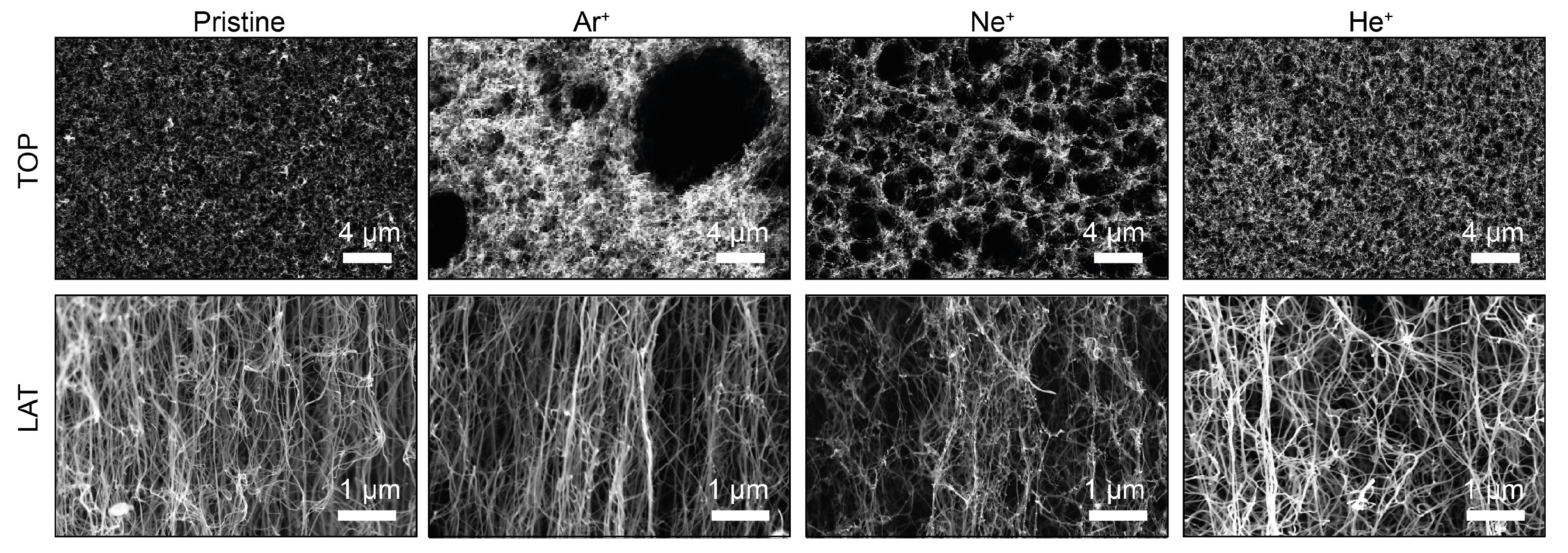
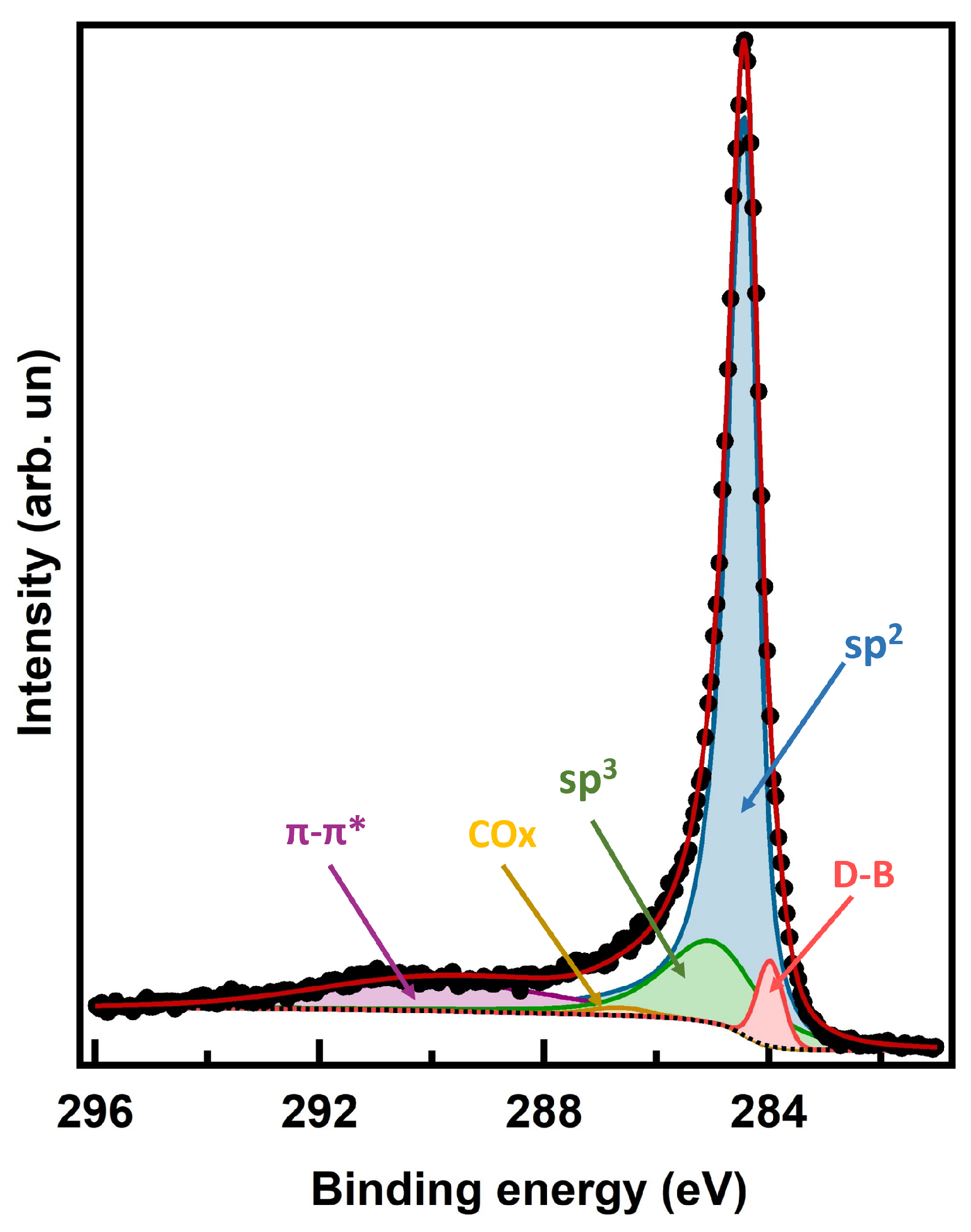
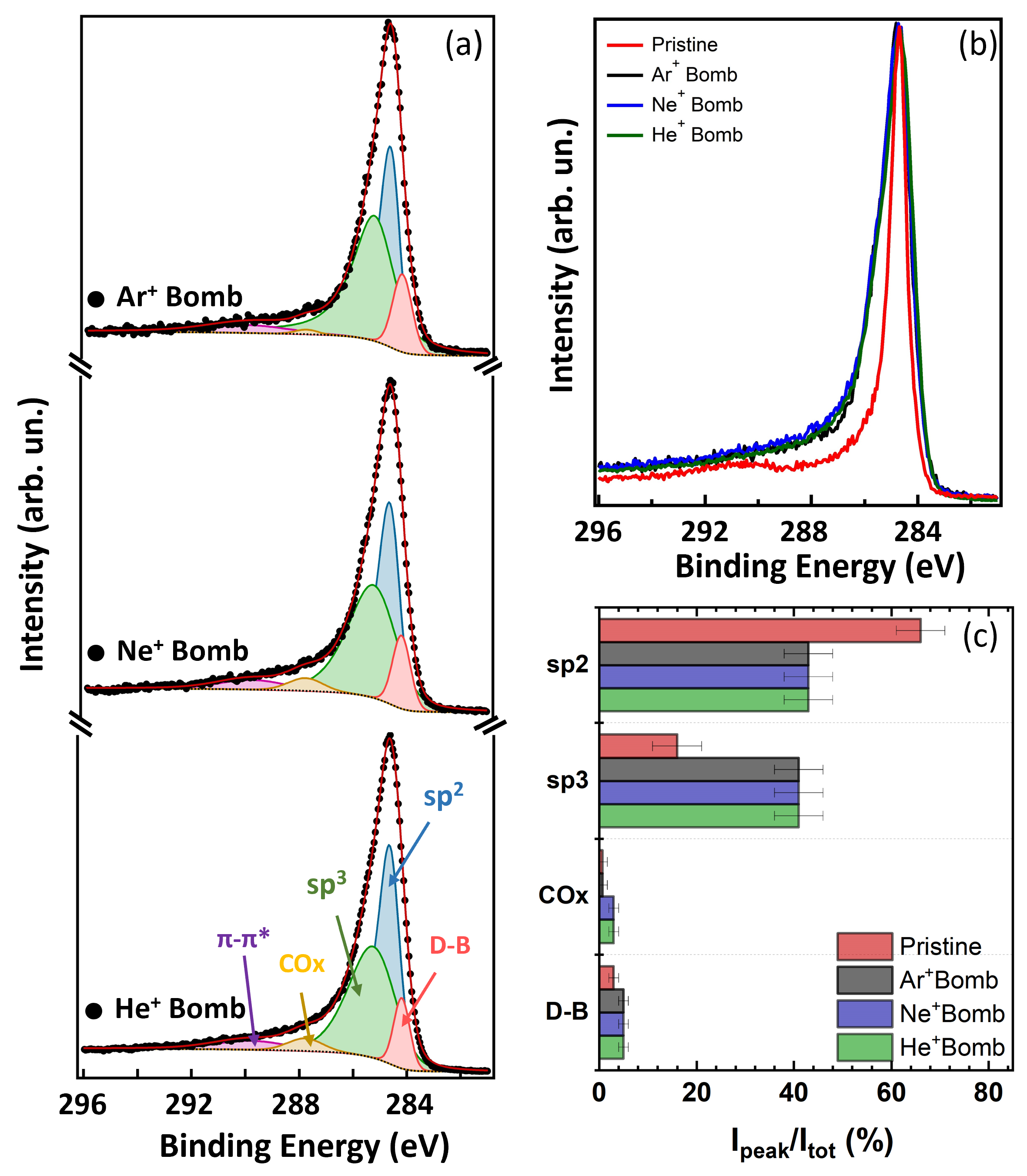
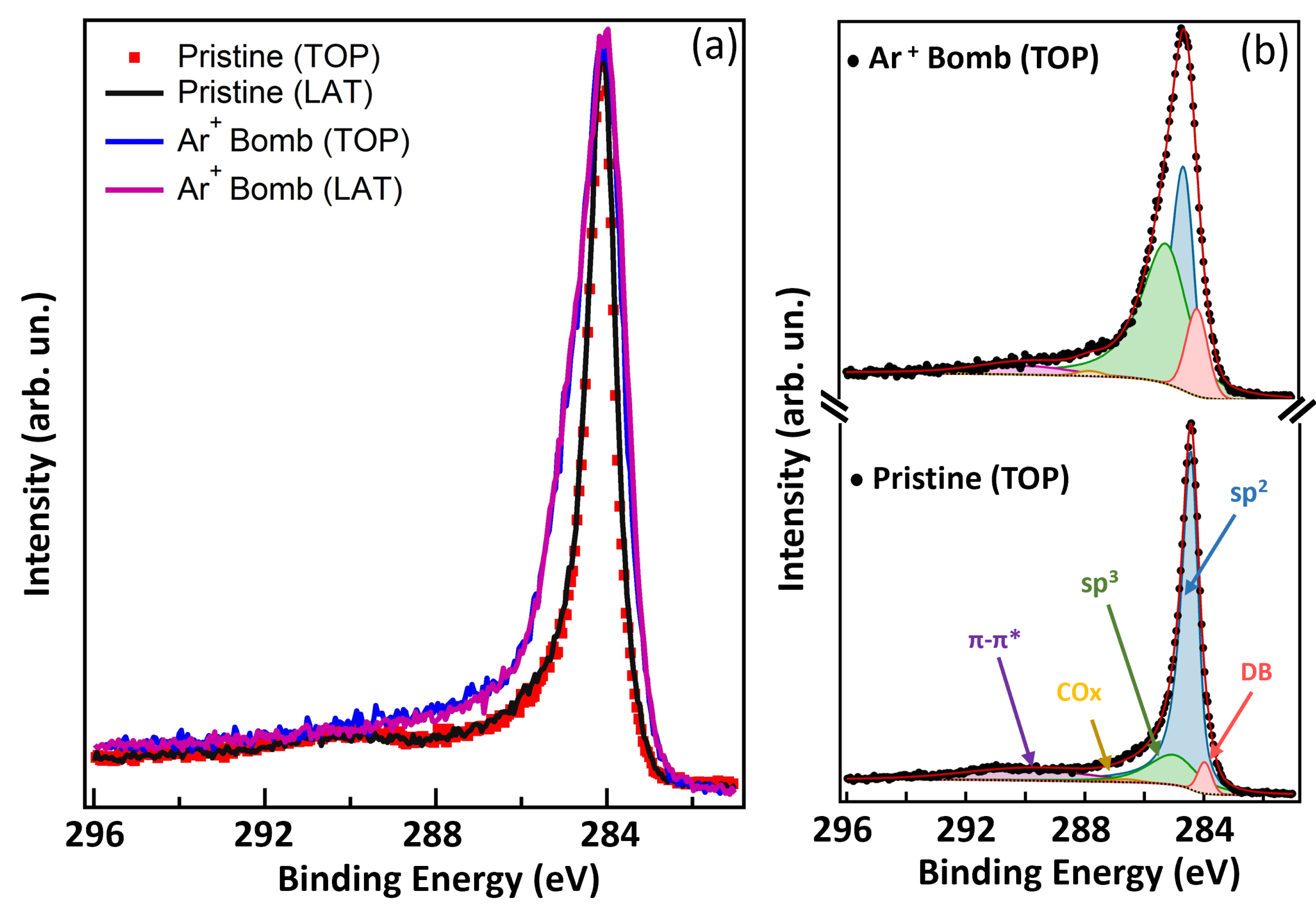
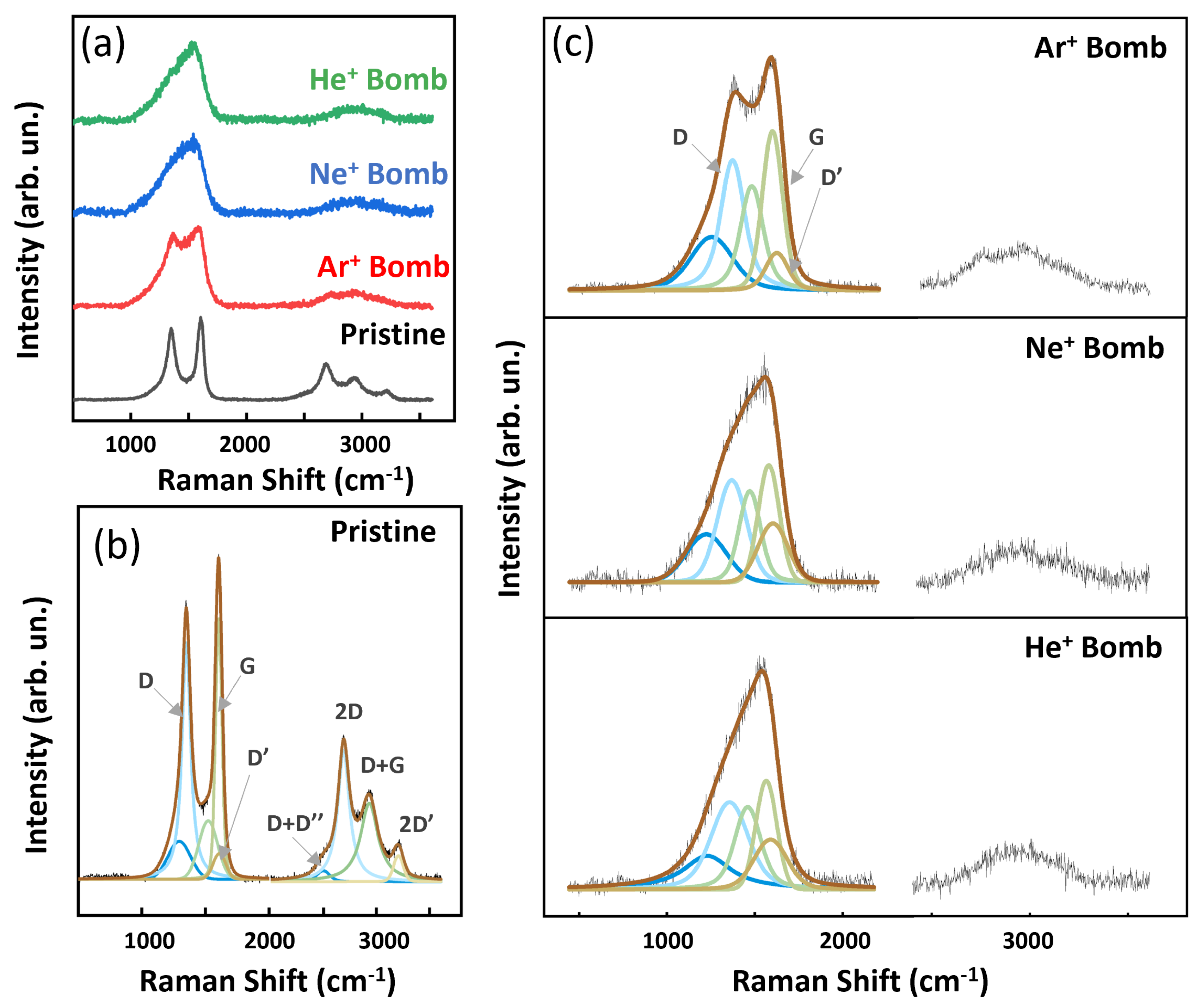
Disclaimer/Publisher’s Note: The statements, opinions and data contained in all publications are solely those of the individual author(s) and contributor(s) and not of MDPI and/or the editor(s). MDPI and/or the editor(s) disclaim responsibility for any injury to people or property resulting from any ideas, methods, instructions or products referred to in the content. |
© 2023 by the authors. Licensee MDPI, Basel, Switzerland. This article is an open access article distributed under the terms and conditions of the Creative Commons Attribution (CC BY) license (https://creativecommons.org/licenses/by/4.0/).
Share and Cite
Tayyab, S.; Apponi, A.; Betti, M.G.; Blundo, E.; Cavoto, G.; Frisenda, R.; Jiménez-Arévalo, N.; Mariani, C.; Pandolfi, F.; Polimeni, A.; et al. Spectromicroscopy Study of Induced Defects in Ion-Bombarded Highly Aligned Carbon Nanotubes. Nanomaterials 2024, 14, 77. https://doi.org/10.3390/nano14010077
Tayyab S, Apponi A, Betti MG, Blundo E, Cavoto G, Frisenda R, Jiménez-Arévalo N, Mariani C, Pandolfi F, Polimeni A, et al. Spectromicroscopy Study of Induced Defects in Ion-Bombarded Highly Aligned Carbon Nanotubes. Nanomaterials. 2024; 14(1):77. https://doi.org/10.3390/nano14010077
Chicago/Turabian StyleTayyab, Sammar, Alice Apponi, Maria Grazia Betti, Elena Blundo, Gianluca Cavoto, Riccardo Frisenda, Nuria Jiménez-Arévalo, Carlo Mariani, Francesco Pandolfi, Antonio Polimeni, and et al. 2024. "Spectromicroscopy Study of Induced Defects in Ion-Bombarded Highly Aligned Carbon Nanotubes" Nanomaterials 14, no. 1: 77. https://doi.org/10.3390/nano14010077
APA StyleTayyab, S., Apponi, A., Betti, M. G., Blundo, E., Cavoto, G., Frisenda, R., Jiménez-Arévalo, N., Mariani, C., Pandolfi, F., Polimeni, A., Rago, I., Ruocco, A., Sbroscia, M., & Yadav, R. P. (2024). Spectromicroscopy Study of Induced Defects in Ion-Bombarded Highly Aligned Carbon Nanotubes. Nanomaterials, 14(1), 77. https://doi.org/10.3390/nano14010077







